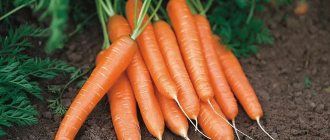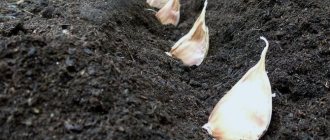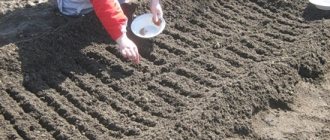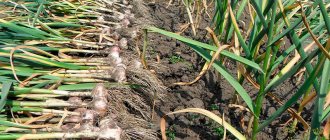Rules for organizing crop rotation in open ground
- In order to ensure productivity, the monoculture is planted in the place where it grew only after 3-4 years. The purpose of annual and continuous alternation of plantings is to prepare the soil for the next plant. It is carried out according to the “tops-roots” principle, the superficial root system replaces the deep one, and vice versa.
- To prevent soil depletion and the accumulation of pathogenic microbes in it, another crop rotation rule is used.
After crops susceptible to certain pests, a plant resistant to them is planted. It’s the same with minerals: after vegetables, which consume some nutrients, crops are grown that need other nutrients.
By following these simple rules for alternating plantings, you can achieve not only a high-quality harvest, but also spend less time and effort on caring for and processing the plantings.
The worst crops for root vegetables
There are a number of plants, planting after which harms the root crop. Gardeners do not recommend the following vegetable predecessors to carrots:
- parsley;
- beans (depletes the soil);
- umbrella plants: anise, dill, coriander, cumin, fennel;
- beets or other root vegetables, except potatoes.
The most dangerous thing on this list is parsley. Its pests attack root crops - it is useless to plant carrots in this area. The same situation is with umbrella plants.
Treatment with chemicals and soil fertilization can partially save the situation. But this will not give a 100% guarantee that a high and high-quality harvest will be obtained.
Carrots grown in soil previously fertilized with manure will give poor results: the fruits quickly deteriorate.
Beets, as the predecessor of carrots, are not recommended for planting for the same reason as beans: beets are a root crop that depletes and compacts the soil. This soil is not suitable for other root crops.
What does compatibility depend on?
The compatibility of carrots with predecessors and successors depends on the minerals consumed and added to the soil.
- Firstly, during growth, a vitamin-rich vegetable needs nitrogen, which can be taken from the air. Due to it, green tops grow and the size of the root crop increases.
- Secondly, there is a need for potassium, which is responsible for photosynthesis, fruit quality and vegetable resistance to disease.
- Thirdly, carrots need phosphorus, which is responsible for its taste. From the above it follows that the predecessors of the orange root vegetable had to consume other microelements or the same ones, but in small quantities.
- Also, carrots must be resistant to diseases of previous plantings.
To grow a good harvest you need to know all the intricacies of the process. Here you can read about the time of planting carrots, seed preparation, planting methods and procedures, seeders, planting patterns, the best neighbors and sowing seeds.
After what can you plant carrots?
Carrots are an unpretentious crop, but if you follow specific sowing rules, you can get good results
- You need to start preparing the soil from September - dig up the soil using the necessary microelements. If the site is constantly fertilized, then there is no need to add fertilizer complexes to the soil.
- It is necessary to plant seeds in bright areas and with a minimum amount of clay.
- To make the soil loose, add sand. And to obtain an appetizing and aromatic root vegetable, the pH of the soil must be set to zero. Ash, chalk or dolomite flour are ideal for this. T
- You also need to prepare the seeds. They must be immersed in an essence of 240 g of water and a spoon of salt for 20 minutes. The seeds that end up at the bottom are washed with warm water and dried. They also need to be disinfected and treated with useful elements.
Carrots should be planted in the spring, depending on the area. There are different ways to sow seeds in the ground: in a row or on a belt, from a watering can or using sand. You can plant the vegetable after specific positive crops to make a large and tasty harvest.
Vegetables grow ideally in the place where tomatoes, onions, cucumbers, potatoes and lettuce were previously grown. It was found that this phased sowing retains many valuable substances in the soil.
Advantages and disadvantages of rotation in the garden
The advantages of crop rotation are:
- Productivity that increases by an average of 20%.
- Interruption of the period of reproduction of harmful bacteria and pathogens, characteristic of monoculture.
- Reducing energy costs for fertilizing the soil, since it will not be too depleted.
Flaws:
- Annual competent planning of planting sites.
- A small area of the plot, if it is a summer house or a vegetable garden. It is very difficult to distribute plantings in the correct rotation of crops on a small perimeter.
Is it possible to sow carrots after onions, garlic, strawberries, cucumbers and other crops?
- Good predecessors for carrots. Correct predecessors not only do not harm subsequent plantings, but also create favorable conditions for them.
- Onions – disinfect the soil.
- Strawberries - their diseases and harmful insects are not afraid of orange root crops. Since carrots are able to consume nitrogen from the air, you will get an excellent harvest on soil poor in this microelement.
- Garlic does not deplete the soil very much; all necessary nutrients will be preserved.
- Cabbage is susceptible to different diseases than carrots.
- Cucumbers – these vegetables belong to the rule “roots replace tops”; they will not cause any harm to carrot plantings.
- Zucchini leaves behind loose and clean soil, where the root crops will form smooth and beautiful.
- Potatoes - consume the same nutrients, but in different proportions. Therefore, in such an area the soil structure will be preserved, and there will be enough microelements necessary for the development of carrots.
- Pumpkin - has a wide and shallow root system, thanks to which the soil remains loose. Also, its roots do not emit any toxic substances.
- Prohibited precursors for orange root vegetables:
- Carrots can be returned to their original planting location only after 3-4 years. Otherwise, the soil will be depleted and the cycle of proliferation of pathogenic microbes will continue. And as a result, productivity will decrease, and root crops will be susceptible to disease.
- Beets - these two vegetables are prone to the same ailments.
- Parsley, celery, dill - have the same pests.
- will have a neutral effect on carrot plantings , since the fruits are terrestrial and suffer from different diseases.
What can you plant next to carrots?
An important point when placing plantings in the garden is the compatibility of different plants. They can either oppress each other or support each other (for example, in pest control).
Find out when to remove carrots from the garden for storage.
When choosing suitable neighbors you should consider:
- plants grown in the same bed should require the same care;
- crops should not compete for the same nutrients;
- should not have common diseases and pests.
- The following crops are considered useful companions:
- Everyone knows that onions repel a pest called carrot fly from carrot plantings. But not everyone knows that tobacco, sage or rosemary can also cope with this;
- legumes (peas and beans) make the soil loose and enrich it with nitrogen;
- you can plant greens nearby (for example, lettuce), which will quickly ripen and free up space, and large leaves will immediately cover the ground and help retain moisture;
- spinach will also shade carrot plantings from the sun;
- tomatoes, radishes, cabbage and radishes are also good neighbors.
- The following should not be placed next to carrots:
- beets or horseradish, which will compete;
- dill, celery and other umbelliferous plants that attract common pests;
- It is not recommended to plant root crops next to apple trees - such proximity worsens the taste of the fruits of both crops.
Did you know? The Portuguese make jam from carrots and sell them to Europeans. According to the law, jam is prepared only from fruits, so they consider carrots not a vegetable, but a fruit.
What vegetables are allowed to be planted the following year after carrots?
Let's consider what is better to plant after the carrot, what is the effect of the orange vegetable on subsequent plantings.
- They will feel good:
- Onions and garlic will have a disinfecting effect on the soil.
- Potatoes – there will be enough nutrients left in the soil for them.
- Radishes - although they belong to the same family, they can be planted. Since radishes ripen early, they do not have time to become infected with diseases.
- Beans and peas saturate the soil with nitrogen.
- Strawberries and garden strawberries will make an excellent harvest.
- Plantings will not be productive:
- Beetroot - due to the similarity of the disease.
- Carrots - there will be no harvest in the second year.
- dill, parsley, celery after carrots
Soil and conditions for growing carrots
Carrots cannot be called a capricious crop, but they do have certain requirements for the composition of the soil and the growing process. The most suitable soil for carrot beds is loose sandy loam or loamy soil. The soil should have a neutral or slightly acidic reaction. Hard, nutrient-poor soil is absolutely not suitable. If you plant carrots in clay soil, the seedlings will be unfriendly due to the formation of a dense crust on the surface of the bed.
In any case, the soil is dug up deeply and loosened before planting - this increases the volume of the future harvest by an order of magnitude. If the soil on your site is not very suitable for carrots in terms of mechanical composition, planting in high beds will be the solution. Average soil nutrition is preferred. Both a lack and an excess of fertilizers are harmful for carrots.
Helpful advice! Never feed carrots with fresh manure, use only humus, otherwise your crops may die.
Excess organic matter in the soil attracts a pest - the carrot fly. To repel the pest, it is better to alternate planting carrots with planting onions and garlic. Excessive content of organic fertilizers also affects the quality of fruits. In this case, the carrots turn out to be curved and can form “horns”. The application of necessary additives and fertilizers depends on the initial composition of the soil.
- Add to peat soil: fine sawdust, turf soil, humus or compost, coarse sand, rotted manure.
- If the soil is sandy, sawdust, turf soil, humus and peat should be used as additives.
- Sand, sawdust, and superphosphate should be added to the black soil.
It is recommended to dig up beds for carrots in the fall. If the soil is too acidic, dolomite flour or chalk is added at this stage. In the spring, on the eve of planting, organic and mineral fertilizers are applied. A few days before planting, the beds must again be dug to a depth of 25-27 cm.
To ensure that the soil warms up well, it is compacted, watered and covered with film.
Just before planting, the soil is loosened again and furrows are made at a distance of 20 cm. The furrows are watered with a solution of potassium permanganate. After this, the bed is ready for planting.
It is better to allocate sunny, unshaded places for planting carrots. It should be watered infrequently, but deeply, so that during the growth process the root crop does not bend in search of moisture, but grows evenly. Mulching with sawdust will help maintain moderate moisture in the soil. They will also increase the looseness of the soil, which will only benefit root crops.
The seedlings will need to be thinned out, leaving a distance of 5 cm between them, otherwise the carrots will turn out too small. Weaker seedlings need to be removed. If the soil in the garden bed is poor in fertilizers, additional fertilizing can be done with special fertilizers for root crops. It is enough to do this 1-2 times per season.
Solving possible problems
Gardeners who know about the rules of crop rotation certainly use them. And for those who found out about them, when the planting has already been carried out and the carrots are sitting in the place of the beets, what should they do?
- First, fertilize the carrot bed with potassium fertilizers and superphosphates to supplement the amount of substances required by the root crops.
- Secondly, a one-time treatment of the ridge with a 1% Bordoski solution will reduce the likelihood of root crops becoming infected.
- Thirdly, there must be repeated weeding. This will protect the plantings from carrot flies. And fourthly, thinning of plantings, which affects the size and type of root crops.
By taking note of these simple rules and recommendations, you can achieve not only a good harvest, but also free up time to do something else.
If you find an error, please select a piece of text and press Ctrl+Enter.
Is it possible to plant after garlic?
Garlic is considered an unusual crop. After harvesting the fruits, many vegetables can be planted in the garden. It is important to follow the rules: Do not sow blood plants.
Combine tops and roots. Everyone knows that the main disease of carrots is the presence of carrot fly worms. As a result, the root crop rots from the inside and becomes bitter.
Summer residents advise sowing red beauty after garlic. This will help fight the main enemy of the root crop. You also need to plant between the rows or along the perimeter of the sown garlic. You can create a special garlic solution against flies. They water the root crop until the end of the growing season.
Sowing onions and carrots in the same row Both crops planted in the same bed have a positive effect on each other and protect against the main insects, the onion and carrot flies. You can plant onions and carrots in the same row using the following methods: before winter onions - sowing carrots, cultivating beacon onions.
Not everyone knows the first option, but if you do everything correctly, the harvest will please you and will allow you to plant some other early-ripening crop after harvesting the onions and carrots.
Steps for preparing the bed:
- The required area needs to be dug up in the fall and humus added. If the soil composition is clayey, you need to add river sand.
- Maintain a combination of rows with a distance between them of 24 cm. For carrots, the cell should have a depth of 2.5 cm.
- Combine leaf soil and sand in equal parts. If necessary, use potassium and phosphorus composts.
- Onions require a 3-4 cm deepening.
- The bulb must be planted in a specific way - slightly pressing and at a distance of 9 cm in a row.
- Add wood ash.
- To prevent seeds from producing inflorescences, you need to sow when the daytime temperature is +8 degrees.
- Each row can be marked with a peg.
- In March we need to build a film greenhouse.
- After 7 days, irrigate the beds and close the greenhouse again. Then irrigate as the soil dries out.
- Weed and loosen the beds.
- To make the free space beneficial, lettuce can be planted between the rows.
About











